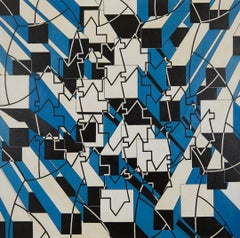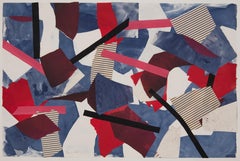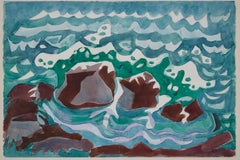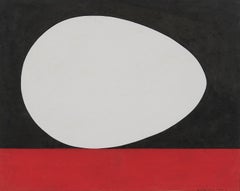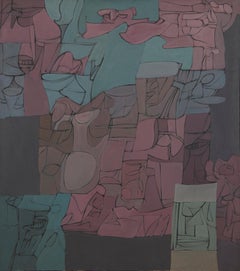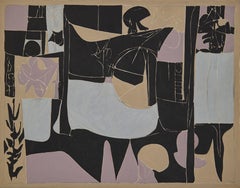WOLFS Abstract Paintings
to
14
14
35
10
31
Overall Width
to
Overall Height
to
102
2
2
10
36
22
18
3
53
36
3
2
53
42
9
4
2
2
1
1
1
1
100
69
69
26
12
43
31
3
3
2
96
104
Monumental Blue/White/Black Geometrical Abstract Late 20th Century Painting
Located in Beachwood, OH
James Massena March (American, 1953-2021)
Untitled
Acrylic on canvas
84 x 84 inches
Provenance: From the Estate of James Massena March
"My painti...
Category
Late 20th Century Abstract Geometric Abstract Paintings
Materials
Acrylic
Lanzorate, Large Abstract Collage, New York Artist
By Joseph Glasco
Located in Beachwood, OH
Joseph Glasco (American, 1925-1996)
Lanzorate, 1985
Monotype with fabric collage and mixed media on paper
Signed and dated lower right, 1/1, titled lower left
31.5 x 48 inches
37 x 5...
Category
1980s Abstract Mixed Media
Materials
Fabric, Paper, Monotype
Small Craft Advisory, 20th Century Abstract Figural Seascape, Cleveland Artist
By Kenneth Marcus Hugh
Located in Beachwood, OH
Kenneth Marcus Hugh (American, 1916-2011)
Small Craft Advisory
Watercolor on paper
Signed lower right
15 in. h. x 22.5 in. w., image
20.25 in. h. x 28.25 in. w., matted
Kenneth Marc...
Category
20th Century Abstract Paintings
Materials
Watercolor
On the Red Line, Black & Red Figural Abstract Ovoid, Cleveland School Artist
By Clarence Holbrook Carter
Located in Beachwood, OH
Clarence Holbrook Carter (American, 1904-2000)
On the Red Line, 1965
Acrylic on textured paper
Signed and dated lower right
24 x 31 inches
32.5 x 39 inches, framed
There is damage ...
Category
1960s American Modern Abstract Paintings
Materials
Acrylic
The Grey Wall, Large Abstract Expressionist Mid-Century Oil Painting
By Richard Andres
Located in Beachwood, OH
Richard Andres (American, 1927–2013)
The Grey Wall, c. 1962
oil on canvas
54 x 48 inches
In original condition with slightly warped stretcher and top of frame is missing, which can ...
Category
1960s Abstract Expressionist Abstract Paintings
Materials
Oil
Crusader, Large Abstract Expressionist Painting, Cleveland School Artist
By Richard Andres
Located in Beachwood, OH
Richard Andres (American, 1927-2013)
Crusader, c. 1969
acrylic on canvas
signed and titled verso
48.5 X 62.5 inches
Richard Andres was born in Buffalo, New York in 1927. A graduate ...
Category
1960s Abstract Expressionist Abstract Paintings
Materials
Acrylic
The New Plans, Large Abstract Expressionist Mid Century Colorful Painting
By Richard Andres
Located in Beachwood, OH
Richard Andres (American, 1927–2013)
The New Plans, 1969
Acrylic on canvas
Signed lower right
57.5 x 48 inches
Bottom part of frame is missing - can be repaired.
Richard Andres wa...
Category
1960s Abstract Expressionist Abstract Paintings
Materials
Acrylic
Saturday on Wednesday, Large Abstract Expressionist Acrylic Painting, 20th C.
By Richard Andres
Located in Beachwood, OH
Richard Andres (American, 1927–2013)
Saturday on Wednesday, c. 1975
acrylic on canvas
signed lower right, signed and titled verso
48.5 x 62.5 inches
Richard Andres was born in Buff...
Category
1970s Abstract Expressionist Abstract Paintings
Materials
Acrylic
S. F. L. Large Abstract Expressionist Mid Century Oil Painting, Cleveland School
By Richard Andres
Located in Beachwood, OH
Richard Andres (American, 1927–2013)
S. F. L., 1955
oil on canvas
signed lower right, signed and titled verso
42 x 70 inches
Richard Andres was born in Buffalo, New York in 1927. A ...
Category
1950s Abstract Expressionist Abstract Paintings
Materials
Oil
Large Abstract Expressionist Mid-Century Acrylic Painting, Cleveland School
By Richard Andres
Located in Beachwood, OH
Richard Andres (American, 1927–2013)
Untitled, 1968
acrylic on canvas
signed lower right, signed and titled verso
88.5 x 50.5 inches
Has an indent and a tear in the canvas. See phot...
Category
1960s Abstract Expressionist Abstract Paintings
Materials
Acrylic
Sailing, Large Abstract Expressionist Mid-Century Oil, Cleveland Artist
By Richard Andres
Located in Beachwood, OH
Richard Andres (American, 1927–2013)
Sailing, 1973
oil on canvas
signed lower right, signed and titled verso
58 x 72 inches
Exhibited: Cleveland Museum of Art, May Show 1973
Richard...
Category
1970s Abstract Expressionist Abstract Paintings
Materials
Oil
Large Pastel Abstract Collage, 20th Century New York/Texas Artist
By Joseph Glasco
Located in Beachwood, OH
Joseph Glasco (American, 1925–1996)
Untitled
1980
Acrylic and collage on canvas
Initialed and dated verso
48 x 48 inches
Joseph Glasco was born in Paul’s Valley, Oklahoma and grew u...
Category
1980s Abstract Abstract Paintings
Materials
Acrylic
Large Mid-Century Abstract Geometric Painting in Green and Black
Located in Beachwood, OH
Leonard Lieb (American, 1912-1977)
Abstract in Green and Black, c. 1950
Oil on masonite
Signed lower center
48 x 24 inches
Leonard Lieb was a Pittsburgh painter of genre scenes who ...
Category
1950s Abstract Abstract Paintings
Materials
Oil
The Sea, Large Mid-Century Abstract Painting, Cleveland School Artist
By Clarence Van Duzer
Located in Beachwood, OH
Clarence Van Duzer (American, 1920-2009)
The Sea, c. 1950
Asphaltum, encaustic and silver leaf on masonite
Signed upper left
48.5 x 48 inches
In the annals of Cleveland art history,...
Category
1950s Abstract Paintings
Materials
Silver
Broken Ice, Large Mid-20th Century Gouache, Op Art Cleveland School Artist
By Edwin Mieczkowski
Located in Beachwood, OH
Edwin Mieczkowski (American, 1929-2017)
Broken Ice, 1976
Gouache and pencil on paper
Signed, dated (Feb. 2, 1976) and titled lower right
27.5 x 37.75 inches
35 x 45 inches, framed
Edwin Mieczkowski, born in Pittsburgh, was a leader of geometric and perceptual abstraction during the latter part of the 20th century. Mieczkowski's work first came to prominence in "The Responsive Eye" exhibition, the nation's first major exhibition of perceptual art, held at the Museum of Modern Art in New York in 1965.
Mieczkowski was also featured in the 1964 article in Timemagazine that first used the term "Op Art" to describe paintings that manipulated visual cues in order to reorder and excite viewers' perceptual responses.
With a complex aesthetic that over time has transcended mere tricks of optical art, Mieczkowski has spent nearly four decades producing geometrically paintings, drawings and sculptures, a genre of modern art that is known broadly as perceptual abstraction.
His output of static and dynamic forms create a body of work, still largely intact, that uses visually disorienting, meticulously arranged lines, dazzling kaleidoscopic colors, and alluring juxtapositions of hue and tone, to playfully and seductively present new challenges for the viewer's eyes. The desired result is an optical effect of perpetual motion, harmonics and rhythm. . . .
Along with Frank Hewitt and Ernst Benkert, Mieczkowski was a co-founder in 1959 of the Anonima* group that worked together in Cleveland and New York and declared itself free from the pressures of the art market and the pursuit of personal fame. Members of Anonima often left their works unsigned and vowed to shun the usual art market venues such as commercial galleries, biennials and competitions. Instead, they engaged in a rigorous, self-imposed program of painting exercises to explore the effects of geometry and color on visual perception.
Although Mieczkowski's work hung side-by-side in the MOMA "Responsive Eye" exhibition with such colleagues as Josef Albers, Victor Vasarely, Richard Anuszkiewicz, Morris Louis, Kenneth Noland, Carlos Cruz-Diaz, Ad Reinhardt and Bridget Riley, all of whom went on to considerable fame and fortune, Mieczkowski chose to eschew commercial exhibition and career promotion. Instead, he spent 39 years teaching at the Cleveland Institute of Art and quietly executing a number of public art commissions while independently pursuing his own intuitive explorations in geometric abstraction.
Mieczkowski pursued virtually no commercial sales of his work. Consequently, the body of work he left behind consists of hundreds of paintings, drawings and sculptures only recently viewed...
Category
1970s Op Art Figurative Paintings
Materials
Gouache, Pencil
20th Century Figural Abstract Expressionist Oil Painting by Woman Artist
Located in Beachwood, OH
Lucile E Lundquist Blanch (American, 1895 - 1981)
Abstract
Oil on panel
Signed lower right
10 x 8 inches
17 x 15 inches framed
Painter and lithographer Lucille Linquist Blanch, born in Hawley, Minnesota in 1895, was, by her mid-thirties, already represented by a number of paintings in the collection of the Whitney Museum of American Art. She would receive a Guggenheim Fellowship in 1933.
She studied at the Minneapolis Art Institute during World War I, 1914 to 1918, with fellow students Harry Gottlieb...
Category
20th Century Abstract Abstract Paintings
Materials
Oil
Rain Garden II, Contemporary Figural Abstract Landscape, New York Artist
Located in Beachwood, OH
Cathy Diamond (American, 20th Century)
Rain Garden II, 2023
Pigment dispersion and acrylic on paper
Signed lower left, signed and dated verso
11 x 14 inches
Cathy Diamond currently ...
Category
2010s Abstract Paintings
Materials
Acrylic, Pigment
White Stone Surrealist Painting, Late 20th Century, Cleveland Female Artist
Located in Beachwood, OH
Sally Lachina (American, 20th Century)
White Stone, 1994
Acrylic on canvas
Signed and dated lower right, signed, dated and titled verso
42 x 42 inches
Sally Lachina is an American a...
Category
1990s Surrealist Figurative Paintings
Materials
Acrylic
Figural Abstract Painting w/ Gears of an Engine, Ohio Artist
Located in Beachwood, OH
James Massena March (American, 1953-2021)
Untitled
Oil on canvas
30 x 48 inches
"My paintings are about space, form and energy. I generally start ...
Category
Late 20th Century Abstract Expressionist Abstract Paintings
Materials
Oil
Colorful Abstract Geometrical Late 20th Century Painting by Ohio Artist
Located in Beachwood, OH
James Massena March (American, 1953-2021)
Untitled
Oil on canvas
30 x 24 inches
"My paintings are about space, form and energy. I generally start ...
Category
Late 20th Century Abstract Abstract Paintings
Materials
Oil
Cosmic Woman, Late 20th Century Figurative Abstraction w/ Nude Woman
Located in Beachwood, OH
James Massena March (American, 1953-2021)
Cosmic Woman
Acrylic on canvas
Signed center right, signed and titled verso
30 x 40 inches
"My paintings...
Category
Late 20th Century Abstract Expressionist Figurative Paintings
Materials
Acrylic
Forest Park Path, Contemporary Figurative Abstract Landscape Painting
Located in Beachwood, OH
Cathy Diamond (American, 20th Century)
Forest Park Path, 2023
Watercolor and acrylic on paper
Signed lower right
11 x 14 inches
19 x 16 inches, framed
Cathy Diamond currently lives ...
Category
2010s Figurative Paintings
Materials
Acrylic, Watercolor
Montalvo #15, Marvin Jones Figural Abstract painting, Cleveland Artist
Located in Beachwood, OH
Marvin Jones (American, 1940-2005)
Montalvo #15
Oil on panel board
Signed verso
29.25 x 20.25 inches
Marvin Jones was a painter, sculptor, printmaker, bo...
Category
Late 20th Century Abstract Paintings
Materials
Oil
Double Focus II Mid-Century OpArt Abstract Geometric painting, Cleveland school
By Julian Stanczak
Located in Beachwood, OH
Julian Stanczak (American, 1928-2017)
Double Focus II, 1963
acrylic on canvas
signed and dated verso
33 x 40 inches
Julian Stanczak (American, b. November 5, 1928) was an American ...
Category
1960s Op Art Abstract Paintings
Materials
Acrylic
Summer Idyl, abstract expressionist painting by Cleveland School artist
By Richard Andres
Located in Beachwood, OH
Richard Andres
American, 1927-2013
Summer Idyl, c. 1985
acrylic and ink on paper mounted on canvas
signed lower right, signed and titled verso
44.75 x 62.75 inches
Richard Andres wa...
Category
1980s Abstract Expressionist Abstract Paintings
Materials
Ink, Acrylic
Twist & the Rain Mid-Century OpArt Geometric Painting by Cleveland School artist
By Julian Stanczak
Located in Beachwood, OH
Julian Stanczak (American, 1928-2017)
Twist and the Rain, 1975
acrylic on canvas
signed verso
30 x 24 inches
Julian Stanczak (American, b. November 5, 1928) was an American painter...
Category
1970s Op Art Abstract Paintings
Materials
Acrylic
Reflections, large abstract expressionist painting by Cleveland School artist
By Richard Andres
Located in Beachwood, OH
Richard Andres
American, 1927-2013
Reflections, 1985
acrylic and ink on paper mounted on canvas
signed lower right, signed, dated and titled verso
52.5 x 72.5 inches
53 x 73 inches, ...
Category
1980s Abstract Expressionist Abstract Paintings
Materials
Ink, Acrylic
Untitled abstract expressionist oil painting by Cleveland School artist
By Richard Andres
Located in Beachwood, OH
Richard Andres
American, 1927-2013
Untitled, c. 1984
acrylic and ink on paper mounted on canvas
signed lower right
19 x 16 inches
Richard Andres was born in Buffalo, New York in 192...
Category
1980s Abstract Expressionist Abstract Paintings
Materials
Ink, Acrylic
Mirror, abstract expressionist painting by Cleveland School artist
By Richard Andres
Located in Beachwood, OH
Richard Andres
American, 1927-2013
Mirror, 1984
acrylic and ink on paper mounted on canvas
signed lower right, dated and titled verso
12 x 12 inches
Richard Andres was born in Buff...
Category
1980s Abstract Expressionist Abstract Paintings
Materials
Ink, Acrylic
The King, abstract expressionist painting by Cleveland School artist
By Richard Andres
Located in Beachwood, OH
Richard Andres
American, 1927-2013
The King of Diamonds Accepts Challenges, 1982
acrylic and ink on paper mounted on canvas
signed lower right, signed and titled verso
47.5 x 47.5 in...
Category
1980s Abstract Expressionist Abstract Paintings
Materials
Ink, Acrylic
The Challenge, abstract expressionist painting by Cleveland School artist
By Richard Andres
Located in Beachwood, OH
Richard Andres
American, 1927-2013
The Challenge, c. 1982
acrylic and ink on paper mounted on canvas
signed lower right, signed and titled verso
60 x 41.5 inches
Richard Andres was...
Category
1980s Abstract Expressionist Abstract Paintings
Materials
Ink, Acrylic
Untitled abstract expressionist oil painting by Cleveland School artist
By Richard Andres
Located in Beachwood, OH
Richard Andres
American, 1927-2013
Untitled, c. 1980
acrylic and ink on paper mounted on canvas
30 x 34 inches
Richard Andres was born in Buffalo, New York in 1927. A graduate of th...
Category
1980s Abstract Expressionist Abstract Paintings
Materials
Ink, Acrylic
L. S. F. vibrant abstract expressionist painting by Cleveland School artist
By Richard Andres
Located in Beachwood, OH
Richard Andres
American, 1927-2013
L. S. F., 1980
acrylic and ink on paper mounted on canvas
signed lower right, dated and titled verso
48 x 65 inches
48.75 x 65.75 inches, framed
R...
Category
1980s Abstract Expressionist Abstract Paintings
Materials
Ink, Acrylic
20th century abstract expressionist oil painting by Cleveland School artist
By Richard Andres
Located in Beachwood, OH
Richard Andres
American, 1927-2013
Untitled, c. 1980
acrylic and ink on paper mounted on canvas
signed lower right
24 x 20 inches
25 x 21 inches, framed
Note: Minor abrasion on lowe...
Category
1980s Abstract Expressionist Abstract Paintings
Materials
Ink, Acrylic
20th century abstract expressionist oil painting by Cleveland School artist
By Richard Andres
Located in Beachwood, OH
Richard Andres
American, 1927-2013
Untitled, c. 1980
acrylic and ink on paper mounted on canvas
12 x 10 inches
Richard Andres was born in Buffalo, New York in 1927. A graduate of th...
Category
1980s Abstract Expressionist Abstract Paintings
Materials
Ink, Acrylic
20th century abstract expressionist oil painting by Cleveland School artist
By Richard Andres
Located in Beachwood, OH
Richard Andres
American, 1927-2013
acrylic and ink on paper mounted on canvas
12 x 10 inches
Note: Small dent in canvas. See pictures for details.
Richard Andres was born in Buffal...
Category
1980s Abstract Expressionist Abstract Paintings
Materials
Ink, Acrylic
Fragment, abstract expressionist mid-century painting, Cleveland School artist
By Richard Andres
Located in Beachwood, OH
Richard Andres
American, 1927-2013
oil on canvas
signed and titled verso
19.5 x 24 inches
20 x 25 inches, framed
Richard Andres was born in Buff...
Category
1970s Abstract Expressionist Abstract Paintings
Materials
Oil
20th century abstract expressionist oil painting by Cleveland School artist
By Richard Andres
Located in Beachwood, OH
RICHARD ANDRES
American, 1927–2013
Untitled, c. 1950
oil on canvas
signed lower left
10 x 7 inches
Richard Andres was born in Buffalo, New York in 1927. A graduate of the Clevelan...
Category
1950s Abstract Expressionist Abstract Paintings
Materials
Oil
Untitled Mid Century Abstract Oil Painting New York Artist
By John Opper
Located in Beachwood, OH
John Opper (American, 1908 - 1994)
Untitled, 1959
Oil on board
Signed and dated lower right
14.75 in. h x 18 in. w.
20 in. h. x 24.5 in. w., as framed
John Opper described the 1930s...
Category
1950s Abstract Abstract Paintings
Materials
Oil
Temple of Evening Reds, 1983 Acrylic OpArt by Cleveland School Artist
By Richard Anuszkiewicz
Located in Beachwood, OH
Richard Anuszkiewicz (American, 1930-2020)
Temple of Evening Reds, 1983
Acrylic on canvas
Signed verso
36 x 36 inches
36.75 x 36.75 inches, framed
Richard Anuszkiewicz was born in E...
Category
1980s Op Art Abstract Paintings
Materials
Acrylic
City Scape, Ovoid Geometrical Abstract Green & Brown Structures
By Clarence Holbrook Carter
Located in Beachwood, OH
Clarence Holbrook Carter (American, 1904-2000)
City Scape, 1978
Acrylic on scintilla
Signed and dated lower right
30 x 22 inches
A surrealist mid-century figural abstract painting....
Category
1970s American Modern Figurative Paintings
Materials
Acrylic
Torso No. 1, Mid-Century Figural Abstract Acrylic Painting
By Clarence Holbrook Carter
Located in Beachwood, OH
Clarence Holbrook Carter (American, 1904-2000)
Torso No. 1, 1967
Acrylic on paper
Signed and dated upper right
15 x10 inches
24 x 20 inches, framed
A mid-century figural abstract painting.
Clarence Holbrook Carter achieved a level of national artistic success that was nearly unprecedented among Cleveland School artists of his day, with representation by major New York dealers...
Category
1960s American Modern Abstract Paintings
Materials
Acrylic
In and Out, mid-century figural abstract vibrant yellow geometric painting
By Clarence Holbrook Carter
Located in Beachwood, OH
Clarence Holbrook Carter (American, 1904-2000)
In and Out, 1963
Acrylic on paper
Signed and dated lower right
22 x 30 inches
Figural abstract vibrant yellow geometric painting.
Cl...
Category
1960s Abstract Abstract Paintings
Materials
Acrylic
Night Garden, mid-century figural surrealist acrylic painting, Cleveland School
By Clarence Holbrook Carter
Located in Beachwood, OH
Clarence Holbrook Carter (American, 1904-2000)
Night Garden, 1972
Acrylic on scintilla
Signed and dated lower right
21.5 x 21.5 inches
24.25 x 24.25 inches, framed
Clarence Holbroo...
Category
1970s American Modern Figurative Paintings
Materials
Acrylic
Ovoid, geometrical figural surrealist acrylic painting, Cleveland School artist
By Clarence Holbrook Carter
Located in Beachwood, OH
Clarence Holbrook Carter (American, 1904-2000)
Ovoid, 1992
Acrylic on canvas
Signed and dated lower right
7.75 x 7.75 inches
9 x 9 inches, framed
Clarence Holbrook Carter achieved a...
Category
1990s American Modern Abstract Paintings
Materials
Acrylic
The Gold Coast, Mid-Century Pastel Pink & Green Painting of Ovoid, Miami
By Clarence Holbrook Carter
Located in Beachwood, OH
Clarence Holbrook Carter (American, 1904-2000)
The Gold Coast, 1979
Collage and acrylic on scintilla
Signed and dated lower right
22 x 30 inches
Clarence Holbrook Carter achieved a...
Category
1970s American Modern Abstract Paintings
Materials
Acrylic
Chimeras, mid-century figural abstract blue acrylic painting
By Clarence Holbrook Carter
Located in Beachwood, OH
Chimeras, 1974
Acrylic and pastel on textured paper
Mid-century figural abstract blue acrylic painting
Clarence Holbrook Carter achieved a level of national artistic success that w...
Category
1970s American Modern Figurative Paintings
Materials
Pastel, Acrylic
Torso No. 5, Mid-Century Figural Abstract Acrylic Painting
By Clarence Holbrook Carter
Located in Beachwood, OH
Clarence Holbrook Carter (American, 1904-2000)
Torso No. 5, 1967
Acrylic on paper
Signed and dated upper right
25 x 20 inches
A mid-century figural abstract painting.
Clarence Hol...
Category
1960s American Modern Abstract Paintings
Materials
Acrylic
Chromatic, Ovoid Head, Geometric Figurative Abstract Acrylic & Collage Painting
By Clarence Holbrook Carter
Located in Beachwood, OH
Clarence Holbrook Carter (American, 1904-2000)
Chromatic, 1965
Acrylic and collage on scintilla
Signed and dated upper right
30 x 22 inches
A surrealist mid-century figural abstrac...
Category
1960s American Modern Abstract Paintings
Materials
Acrylic
Abstract Landscape, large mid-century green painting, COBRA art movement
Located in Beachwood, OH
Erik Ortvad (Danish, 1917 - 2008)
Abstract Landscape, 1946
Oil on canvas
Signed and dated lower right
32 X 37.5 inches
35 x 40.5 inches, framed
Born in 1917 in Copenhagen, Erik Ortvad was a surrealist painter and a founding member of the COBRA art...
Category
1940s Abstract Impressionist Abstract Paintings
Materials
Oil
Mid-20th Century abstract geometric oil painting by Cleveland School artist
By Joseph O'Sickey
Located in Beachwood, OH
Work sold to benefit the CLEVELAND INSTITUTE OF ART
Joseph B. O’Sickey (American, 1918–2013)
Untitled, c. 1950
Oil on paper
Signed lower right
12.5 x 19 inc...
Category
1950s Post-Impressionist Abstract Paintings
Materials
Oil
20th century abstract still life by Cleveland School artist
By Joseph O'Sickey
Located in Beachwood, OH
Work sold to benefit the CLEVELAND INSTITUTE OF ART
Joseph B. O’Sickey (American, 1918–2013)
Still Life
Oil and graphite on paper
Signed lower left
12.25 x 1...
Category
Late 20th Century Post-Impressionist Abstract Paintings
Materials
Oil, Graphite
20th C. Figurative Abstract Painting Cleveland School African American Artist
By Beni E. Kosh
Located in Beachwood, OH
Beni E. Kosh/Charles Elmer Harris (American, 1917-1993)
Untitled
Oil on canvas board
Estate stamped #611 verso
24 x 18 inches
Charles Elmer Harris was born in 1917 in Cleveland, Oh...
Category
20th Century American Modern Figurative Paintings
Materials
Oil
Mandala No. 15, Abstract Ovoid Geometrical Mid-Century Painting Cleveland School
By Clarence Holbrook Carter
Located in Beachwood, OH
Clarence Holbrook Carter (American, 1904-2000)
Mandala No. 15, 1969
Acrylic on paper
Signed and dated verso
27.5 x 22 inches
Clarence Holbrook Carter achieved a level of national ar...
Category
1960s American Modern Abstract Paintings
Materials
Acrylic
Transection w/ Architectural Forms, Geometrical Figurative Abstract Acrylic
By Clarence Holbrook Carter
Located in Beachwood, OH
Clarence Holbrook Carter (American, 1904-2000)
Transection with Architectural Forms, c. 1980s
Acrylic and graphite on board
12 x 20 inches
A surrealist mid-century figural abstract ...
Category
1980s American Modern Abstract Paintings
Materials
Acrylic, Graphite
Double Ovoids, Mid-Century Blue & Black Figurative Abstract Ovoids
By Clarence Holbrook Carter
Located in Beachwood, OH
Clarence Holbrook Carter (American, 1904-2000)
Double Ovoids with Blue and Black, 1960s
Acrylic on scintilla
15.25 x 12.25 inches
A surrealist mid-century figural abstract painting....
Category
1960s American Modern Abstract Paintings
Materials
Acrylic
Maze, 20th Century Geometric Figurative Abstract Acrylic Painting
By Clarence Holbrook Carter
Located in Beachwood, OH
Clarence Holbrook Carter (American, 1904-2000)
Maze, 1982
Acrylic on cardboard
Signed and dated upper right
7 x 9.5 inches
A surrealist mid-century figural abstract painting.
Clar...
Category
1980s American Modern Figurative Paintings
Materials
Acrylic
Large 20th century abstract painting by contemporary Ohio artist, 3.5 x 4.5 feet
Located in Beachwood, OH
James Lepore (American, 1931-2024)
Untitled (Abstract), 1962
Oil on canvas
Signed Lepore 62 lower right
43 x 55 inches
James Lepore was an American artis...
Category
1960s Abstract Abstract Paintings
Materials
Oil
Dichotomy, mid-century figural abstract green oil painting
By Clarence Holbrook Carter
Located in Beachwood, OH
Clarence Holbrook Carter (American, 1904-2000)
Dichotomy, 1962
Oil on paper
Signed and dated upper left
20 x 25 inches
Mid-century figural abstract green painting of woman swimming ...
Category
1960s American Modern Abstract Paintings
Materials
Oil
Untitled Black & White Abstract Painting, CoBrA Movement
Located in Beachwood, OH
Theo Wilhelm Wolvecamp (Dutch, 1925 - 1992)
Untitled
Oil on canvas
Signed and numbered 21 verso
15.75 x 19.75 inches
Theo Wilhelm Wolvecamp was a Dutch artist and member of the COBRA group...
Category
Mid-20th Century Abstract Abstract Paintings
Materials
Oil
